Our Summer Cruise 2016
May 16 - 22 |
May 23 - 29 |
May 30 - Jun 5 |
Jun 6 - 12 |
Jun 13 - 19 |
Jun 20 - 26 |
Jun 27 - Jul 3 |
Jul 4 - 10 |
Jul 11 -17 |
Jul 18 - 24 |
Jul 25 - 31 |
Aug 1 - 7 |
Aug 8 - 14 |
Aug 15 -21 |
Aug 22 - 28 |
Aug 29 - Sep 4 |
Sep 5 - 11 |
Sep 12 - 18 |
Sep 19 - 25 |
Monday, July 18
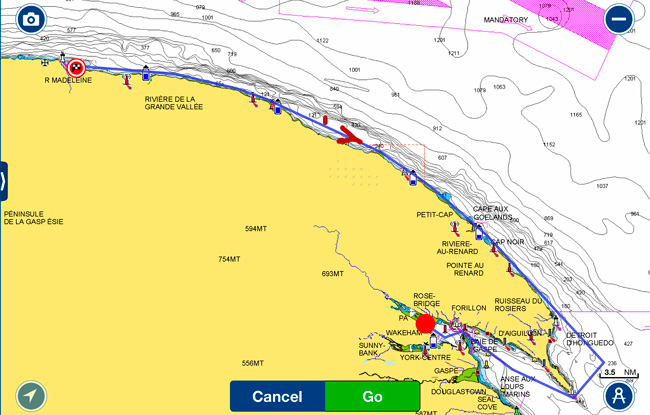
Riviere Madelaine, QC to Gaspe - 81nm
Up early with the sun (5:30 am) for a long run of around 80 nm to Gaspe to gain some ground on the rest of the gang while they are in port. It was a perfect day to be out on the water making this run as we go from easterly to southeast and with a short run to southwest and then northwest - only missed out northeast to make a circle. The wind were light from the ESE and the water flat for the majority of the way as we hugged the south shore of the St. Lawrence running in 30-50' of water just offshore getting good views of the small towns and villages on the way.
- Grand Vallee (pop. 1137) where they are re-building the harbor
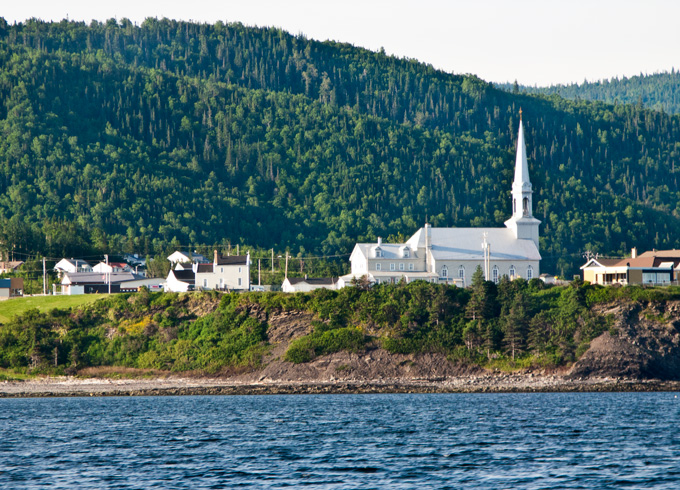
During the first few hours, we had a slight adverse current of 1/2 kt but were still making a steady 8 kts of progress towards Gaspe. Around 8:30, the waves began to pick up but were on the bow as the wind moved around to the SE as we passed the Point a la Renommee lighthouse:
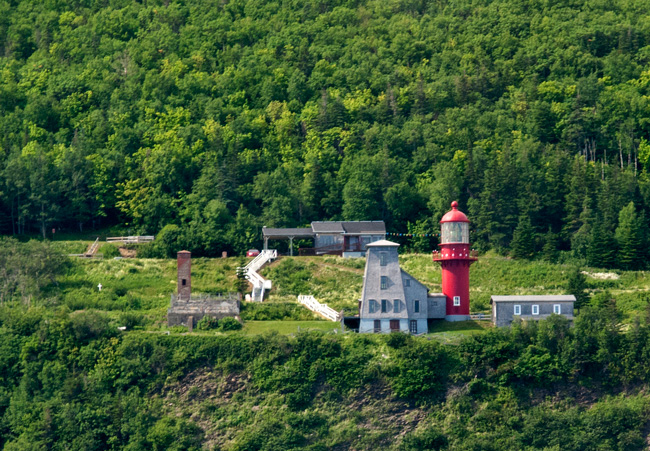
Some other places along the way:
- Anse a Vallee - no church; must have been too poor to build one!
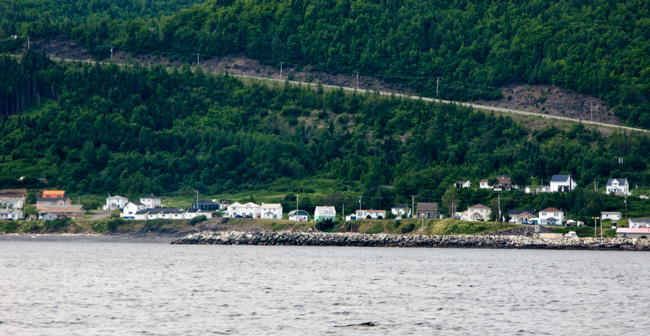
- Dragging a net all round us:
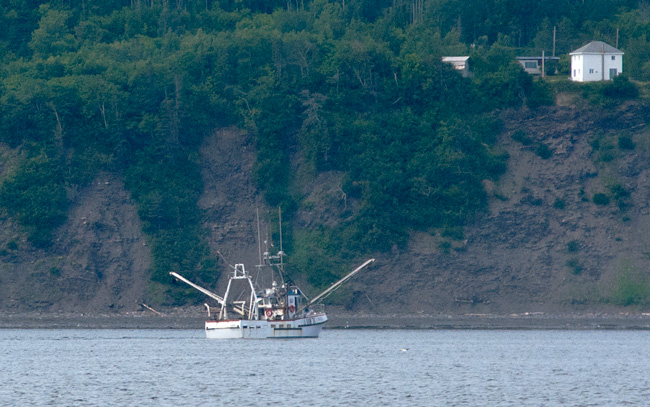
- Sainte-Maurice-de-L'Echouerie (pop. 2800):
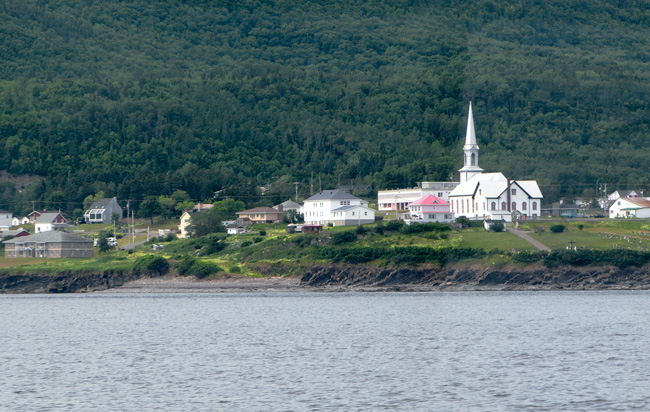
- Fishing boat From Riviere-Renard checking us out:

Past Riviere-Renard, the current suddenly switched, in our favour and we ended up almost 1.5 kts. better off, even though the waves had picked up a little to two feet. The Cap Des Rosiers Lighthouse came into view soon after and we had a great view from just offshore; more about this lighthouse later this week.
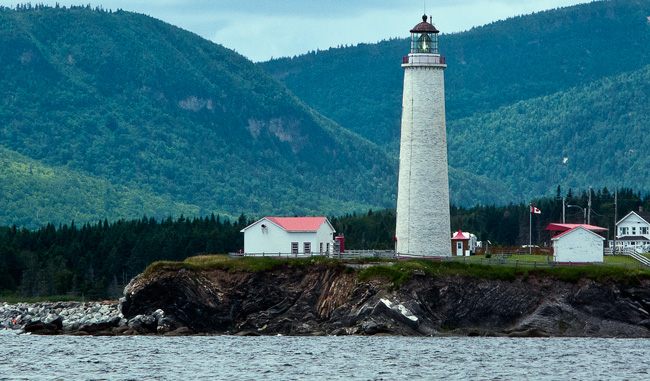
Just past the Lighthouse, the scenery changed dramatically as we went from 35 foot high shores to over 700 feet of limestone cliffs with the 40 foot Cap Gaspe Lighthouse perched on top.
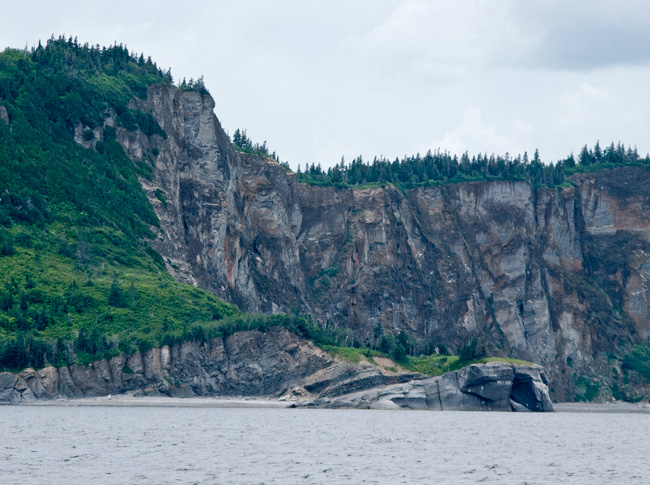
Visibility diminished as we were now into four and five foot waves - a wet ride! .... and not much opportunity to get some good photographs:
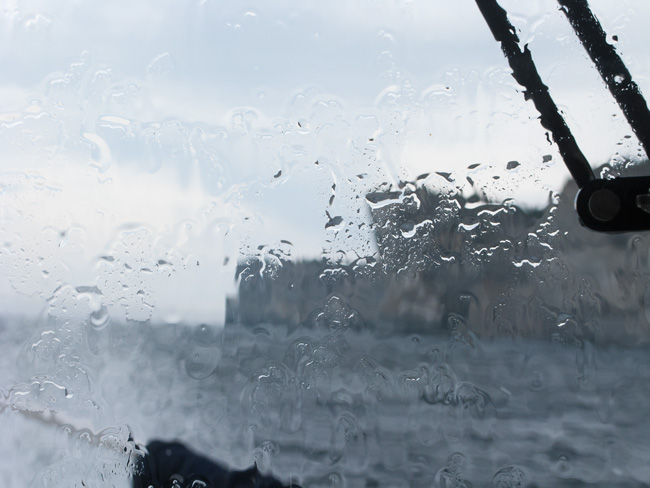
What it would look like on a good day courtesy of Google Images:
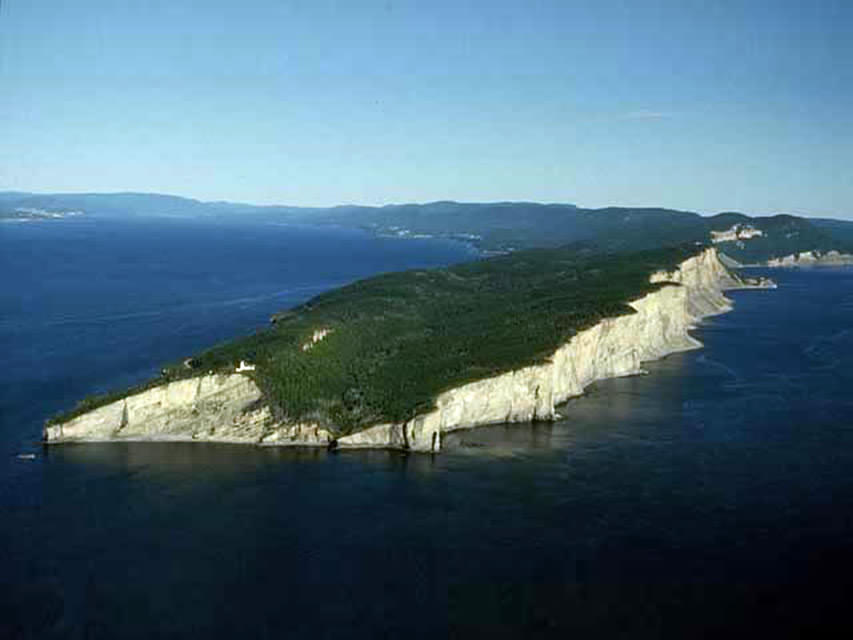
Just round the corner at the left hand tip in the photo above, the waves were on the stern and things calmed down rapidly as we made the 14 mile run down to Gaspe, where we thought it was wise to let the two RCMP RIBs fill with fuel (a 30 minute process) before we topped up our tanks and headed to our slip.
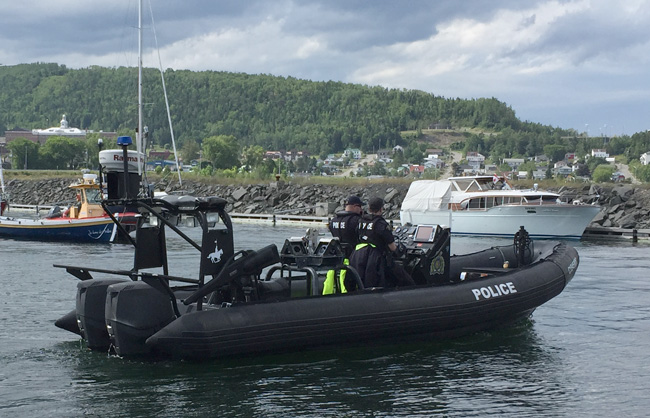
While we were waiting, we chatted to the helmsman of one of the RIBs. The two RIBs are attached to the Canadian Coast Guard vessel Louisbourg stationed in Gaspe and are part of the Marine Security Enforcement Team program tasked with marine security in the Great Lakes and St. Lawrence Seaway regions.. The program combines the law enforcement powers of the Royal Canadian Mounted Police with Canadian Coast Guard vessels and their expertise in order to provide an armed, on-water law enforcement capacity. The RIBs are able to deliver a fast, armed response to potential threats. By "fast", think 50 kts and "armed" think .50 caliber deck mounted. The RCMP crew are actually "mounted" as their seats are like saddles on air cushioned posts.
On the way today, the weather had deteriorated and the long-range forecast didn't look to good for the next two days so we called Budget car rental and arranged a two day car rental to explore the area. Some kind boaters overheard our conversation in the marine office/lounge trying to find out how we could get to the airport 9 km. away and offered to drive us there later in the evening. Another example of boaters helping boaters. We had rented a subcompact and were fortunate to get upgraded to a fully loaded Ford Taurus as they had none; same price!
With keys to a car, so many things are possible that we could not do otherwise. Just the 2 km. trip to the supermarket was easy. The next two days sightseeing would have been impossible.
We are just beginning our tenth week on the water and to give you some perspective of our trip so far, here is a map of our progress to date:

We have travelled 1560 nm so far on the trip. Our average speed over this distance has been 7.6 kts and we have accumulated 205 hours on the engine. We have approximately 1000 nm to go to Maine plus whatever we do in the Bras D'or Lakes in Cape Breton.
Tuesday, July 19
Up early to get the best use of our time with the rental car. Sunny morning but increasing winds so we decided to head for Perce about 65 km away around the Gaspe Bay to see the famed Perce Rock and visit Bonaventure Island.
A very scenic ride to get there with the route around the bay beginning at sea level with many water views, past the salt marshes at Malbaie, and gradually rising to the limestone cliffs below...
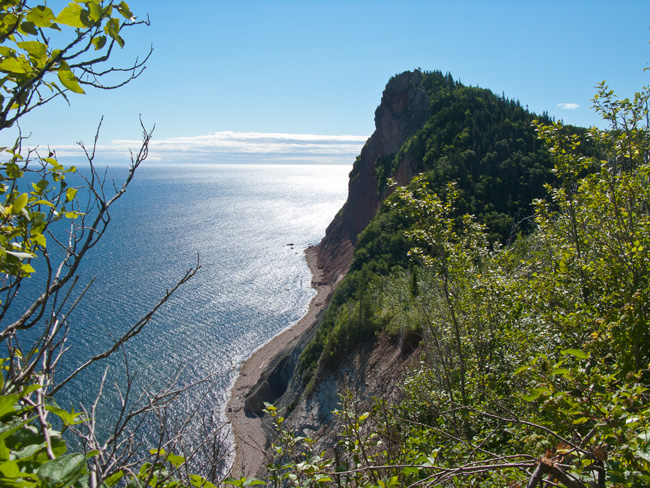
Roadside Viewpoint
Distant view of Perce Rock....
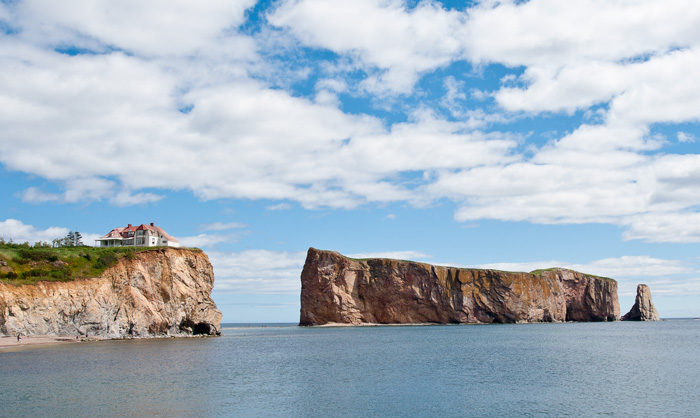
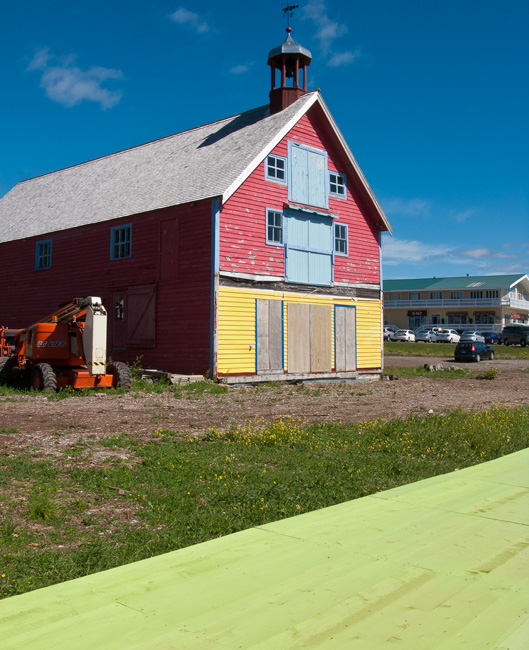
They Like Bright Colors in Perce
Breakfast was calling by the time we arrive in Perce and we found the Maison De Pecheur on the waterfront, probably a busy place normally but empty around 10:00am. Had the "Quebecoise" - much like a full English (down to the baked beans and a little pot of lard for the toast...no butter here). Judy's was nearly as big.
After indulging, we caught the small ferry boat that takes you up close to Perce Rock and then over to Ile Bonaventure. Percé Rock is a huge sheer limestone/shale rock formation off Percé Bay. Percé Rock appears from a distance like a ship under sail. It is one of the world's largest natural arches located in water and is considered a geologically and historically rich natural icon of Quebec. Today it is a major tourist attraction in the Gaspesie region.
The name is attributed to the pierced rock that formed an arch 49 ft high on its seaward southern end, as though a needle had cut through the 300 foot high rock. At the time the French arrived in the area (Jacques Cartier in 1534), there were another two arches between the column at the far end and the main rock which were eroded to the point of collapse in the mid 1800s. It is possible to walk out to the Rock at low tide when a small bar is exposed but the best views are from a boat.
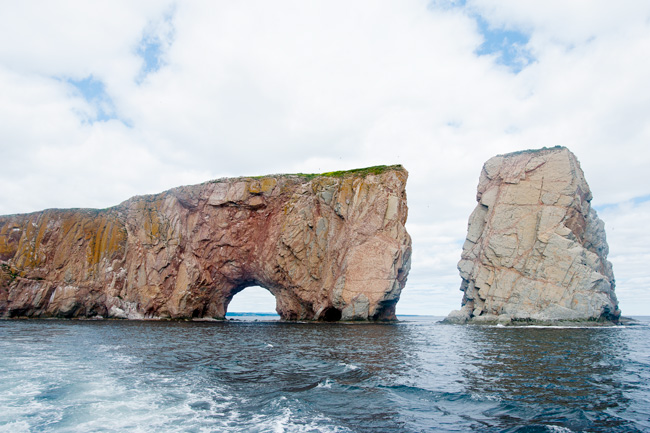
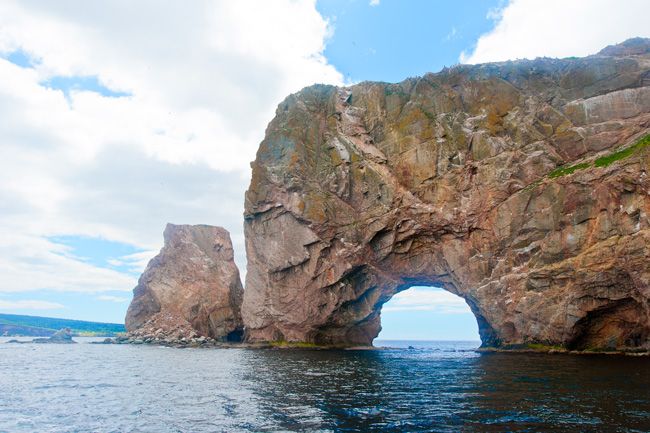
The it was off for a short ride around Bonaventure Island before docking at the Park.
Bonaventure Island, along with Percé, were among the early seasonal fishing ports of New France, and were associated with the lineage of Nicolas Denys. Settlers from southern Ireland came in the early 1790s. Peter Du Val, a native of Jersey, set up a fishery company before 1819 and the company endured until 1845. The island became a migratory bird sanctuary in 1919 due to the 1916 Migratory Bird Convention between Canada and the United States. The Province of Quebec acquired ownership of the entire island by act of expropriation in 1971, evicting the whole population of 35 families. Later, in 1985, the Province of Quebec grouped it together with Percé Rock into the Bonaventure Island and Percé Rock National Park). One of the largest and most accessible bird sanctuaries in the world, with more than 280,000 birds; 293 species have been recorded here. The major attraction here though is the northern gannet population of around 50,000 pair on the east side of the small island perched on top of the cliffs. Bonaventure Island is a major tourist destination with boat and island tours from May to October.
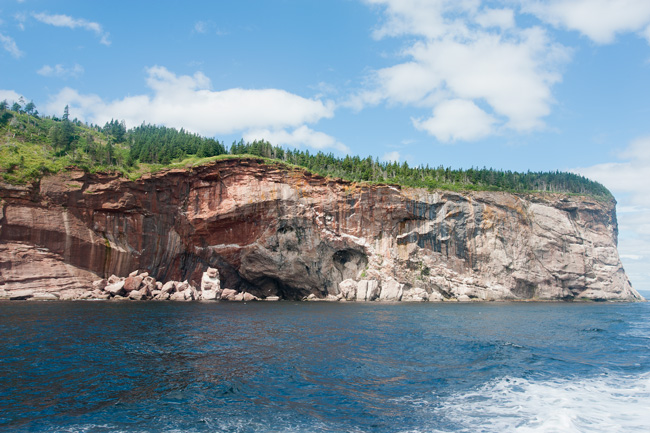
East Side of the Island
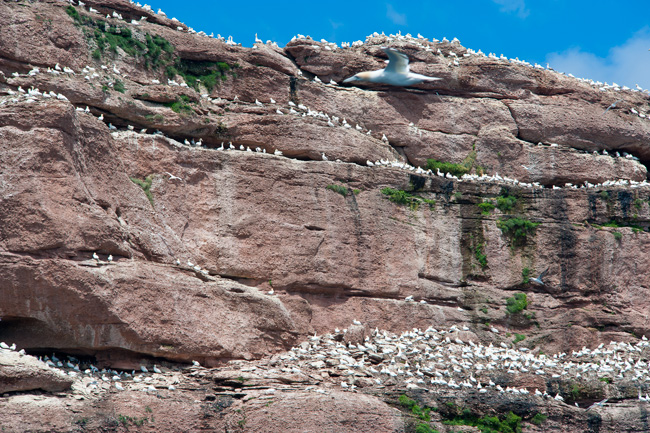
Just a Few of the Nesting Gannets
The gannet colony is on the opposite side to the dock and park entrance and there are several ways to get there; all on foot. We did the 9k version, mainly through the woods but with a great view back to Perce Rock as we climbed to the high point of the Island.
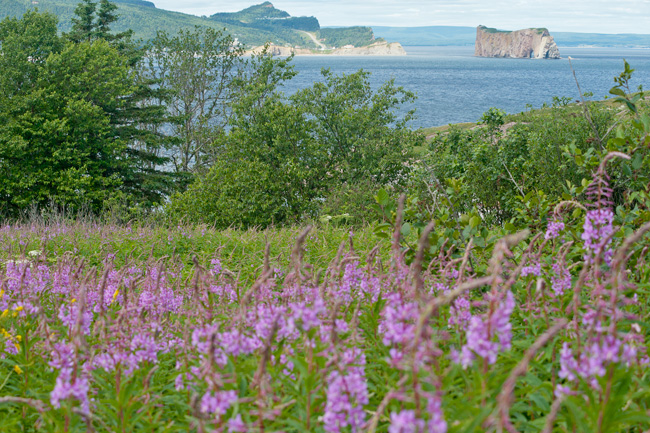
The main gannet colony nests right at the top of the cliff shown earlier and we sat for at least an hour watching their acrobatics on the updraft created by the cliff.
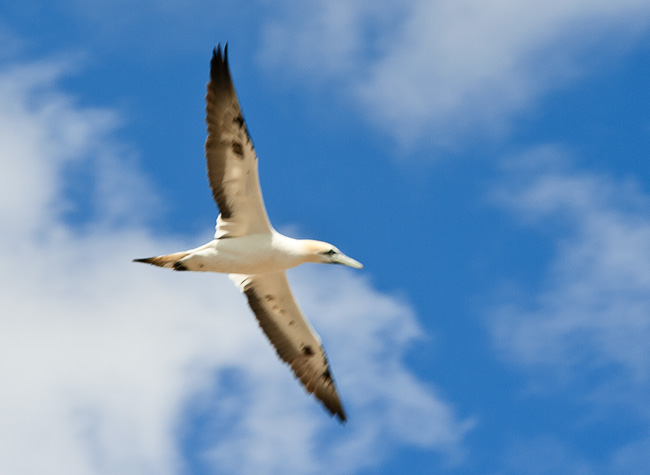
You can literally approach the colony within feet and get a close-up view....
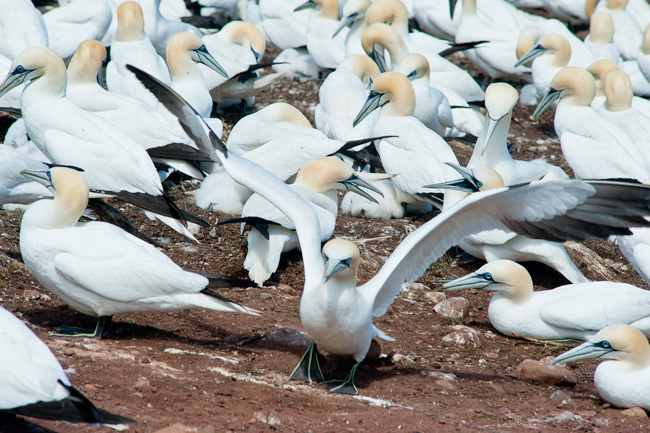
Not a Bit Bothered By Us 6 Feet Away
Gannets are monogamous and return to the same breeding site year after year, laying one egg each year. They have a nest area of about 2'6" and will return to exactly the same location. Somehow they can distinguish "their spot" in a mass of nesting gannets.
The adults feed their offspring for 11 or 12 weeks, until they are strong enough to leave the nest for good. A chick will glide from the nest down to the sea after 75 days, which will mark the point at which it separates permanently from its parents. Young birds that weigh around 9 lb at this point will not be able to fly so they are unable to return to the cliff. Their fat reserves allow them to pass two or three weeks without eating before they can fly and dive to catch their own food. Adult gannets can dive at up to 60 mph and spot fish from 45 feet up in the air, penetrating the water to depths of 16 feet after their prey.
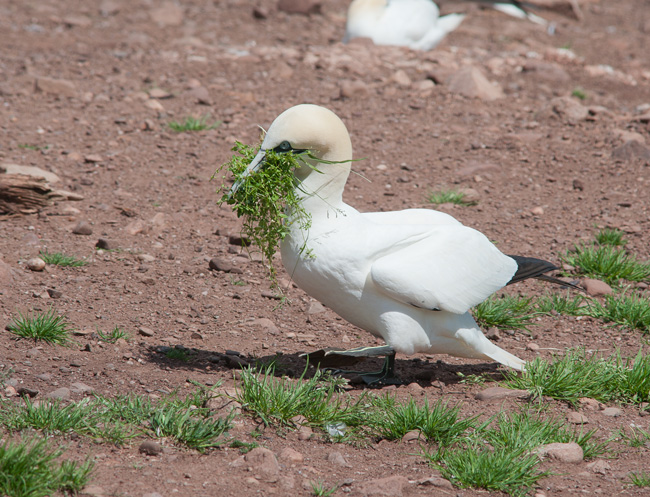
Dean - They Must Have the Occasional Vegetarian Gannnet!
After the return hike to the Park entrance area, we explored the 1840s house of the manager of the cod fishery on the Island that has been restored by the Park. Dried and salted cod was a big export back to France and this house represents the status the manager held in the small community where he was essentially the "Governor".
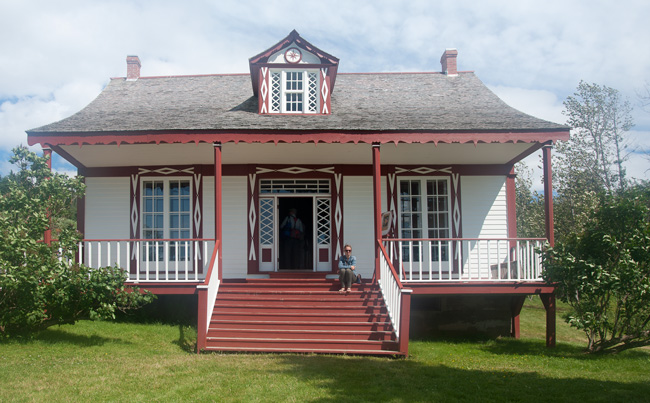
By the time we were ready to leave, the winds had built a good sea out there and the ferry took three attempts to dock before it was successful and we boarded for the short run back to Perce .... not a good day to be out there and glad we stopped in Gaspe for a couple of days. On the way out of Perce, we took a short road to the headland and were glad we did as there are the remnants of an old fishing community near the top and some spectacular views over Perce bay, The Rock and out to the Island.
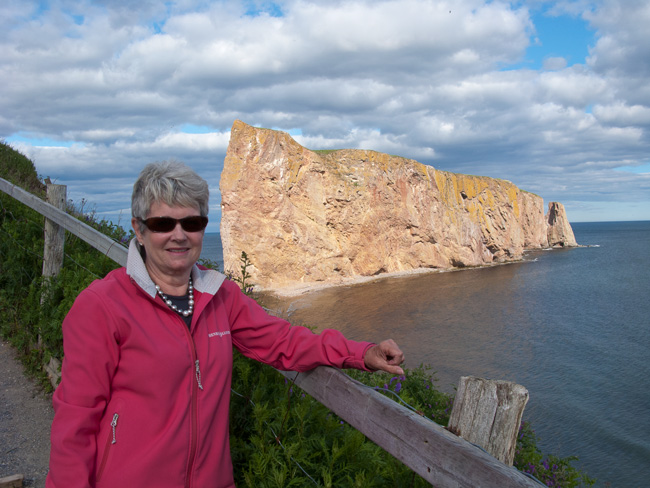
Hot, But the Wind was Howling!
A couple of other detours on our return took us through the Malbaie Salt Marsh, one of the largest bird sanctuaries in Canada, hosting numerous bird species and an important migratory stopping places for many birds on their way south.
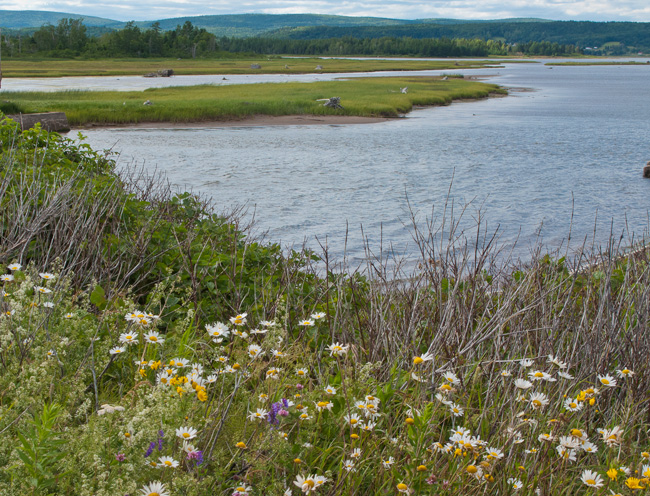
We also found the ultimate hurricane harbor at Malbaie to duck into if our journey south turned bad!
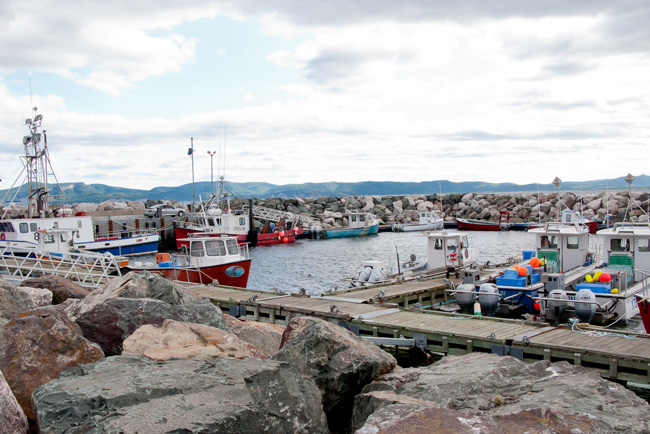
They know How to Build Good Small Harbors in Quebec!
and
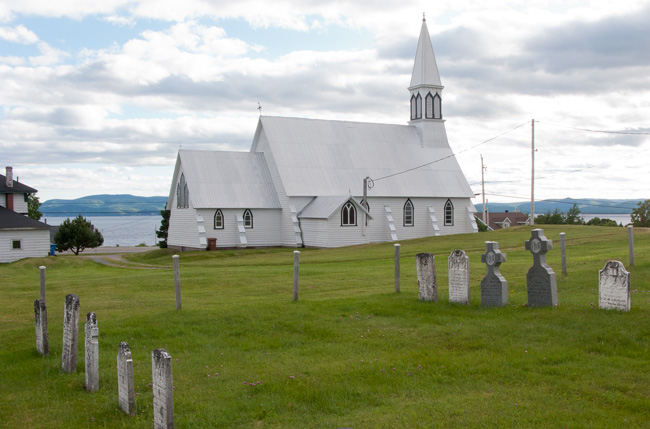
Well-kept Little Churches
So ended a 12 hour day that was packed with views, birds, and water. We slept early and well.
Wednesday, July 20
An early start to explore the area north of Gaspe that we only saw from the water as we made our way around from Riviere Madelaine. First on our list was Riviere au Renard, the fishing capital of Quebec, once the home of over 200 boats fishing the Bay of St. Lawrence and further afield. Today, with cod fishing dramatically limited it is still the major fishing fleet in the area. When we arrived, the short season had ended with only a few boats left in the commercial port but probably 60 large boats on the hard until next Spring; they must make their money in a short time. The recreational marina did not look too attractive so we were happy we made the long run to Gaspe.
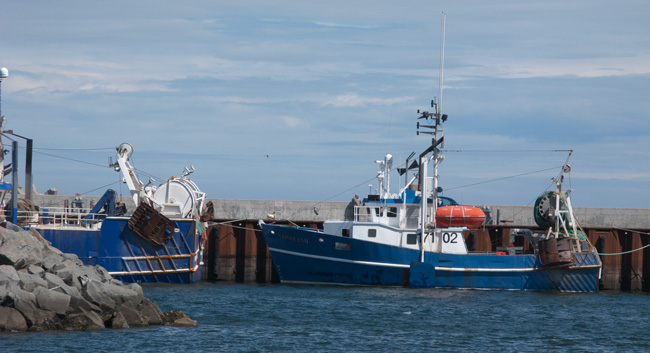
A Couple of the Few Boats Left in the Water
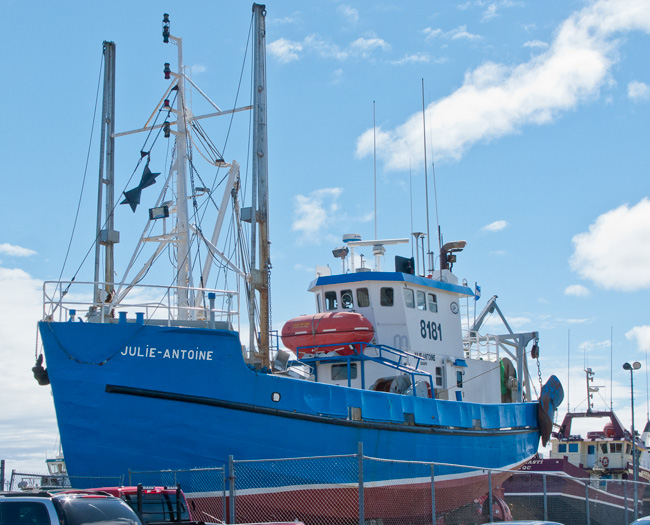
One of the Typical Trawlers on the Hard
Down by the port, we had breakfast at a unique "locals only" restaurant. The interior was decorated with old album covers on one wall and a large collection of old cameras on the other. They didn't match the Quebecois from yesterday but had the beans and the lard! The restaurant is run by two sisters and along the corridor to the rest rooms they have a series of little shops including a uniform shop, a tanning salon, a hairdressers, a hardware store - very enterprising people.
Heading east, we came to Cap Rosier and its lighthouse that we passed yesterday. Entry to look around was $4 and we signed up for the deluxe $10 package of entry and the tour. It turned out to be well worth it with a small tour group, a very knowledgeable guide, and a customized English translation just for us.
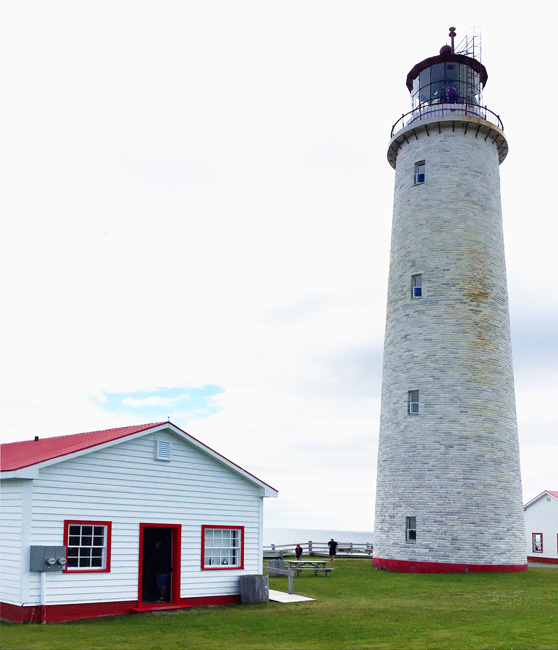
Cap des Rosiers Lighthouse
Prior to the lighthouse, hundreds of sailing vessels had close encounters with the rocky waters below Cap des Rosiers. In just the years from 1840 to 1848, there were eight shipwrecks with major loss of life including the Carrick's of Whitehaven, a brig sailing from Sligo to Quebec in 1847 with 183 Irish emigrants fleeing the worst year of the Great Potato Famine; only 48 survived.
The lighthouse, built between 1853 and 1858, at 122 feet high is Canada's tallest lighthouse. The soaring cylindrical tower is capped by a light in a large metal dome-covered lantern. The tower was built of stone imported from England and its walls taper from 9 feet thick at the base to 3 feet at the top. Originally cased in brick, due to poor mortar, the outside was re-faced in white marble almost a century later. Since 1858, it has operated using its original optical apparatus, although in 1981 it became a completely automated lighthouse and its 14th keeper retired.
The tour was very comprehensive covering each of the nine floor of the lighthouse and what it would have been like to man the station; the engine house that provided compressed air for the foghorn; the canon used before the foghorn; and the history of the keepers.
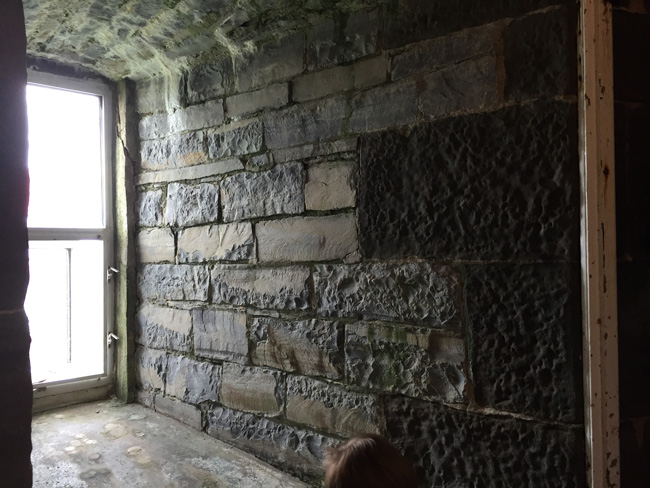
The Intricate Stonework Midway Up - 6 Feet Thick
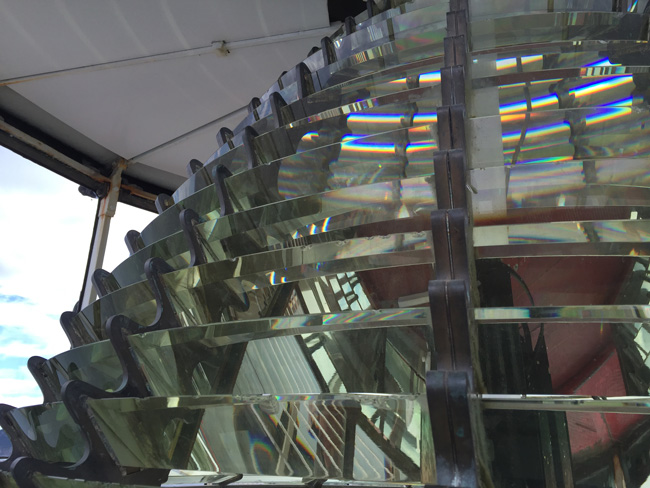
The Top Part of the Original Light Lens from Lapaute et Sautter in Paris
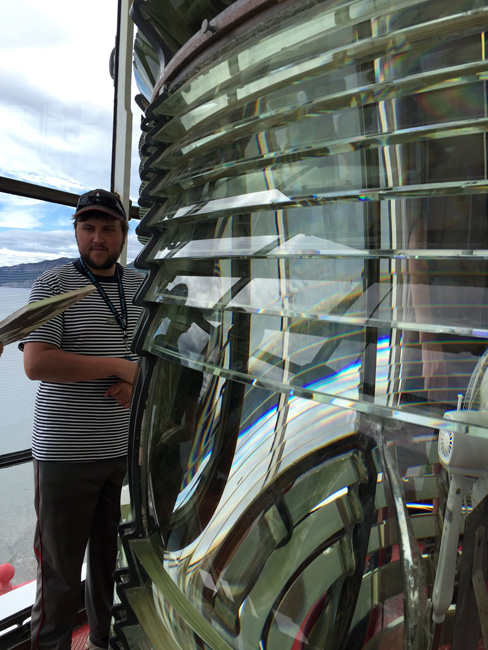
The Main Body of the Lens ...and Our Guide
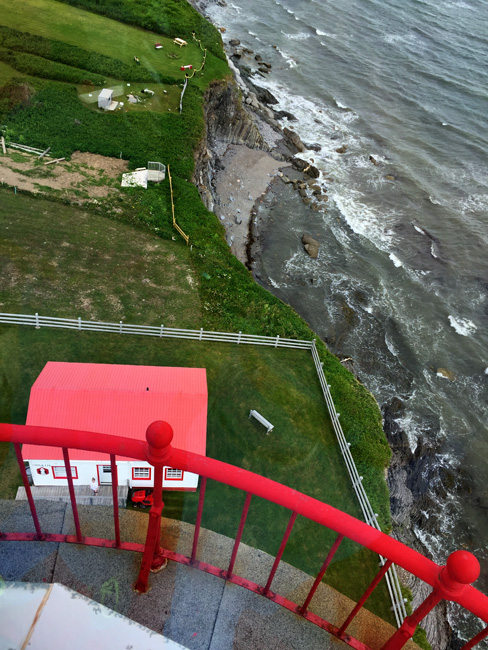
View From the Top Towards Quebec
If you are ever in the area, a visit is a must.
Our next stop around the Gaspesie area was a quick visit to Forillon National Park that encompasses much of the Gaspe Peninsula from Riviere au Renard to the Southeast.
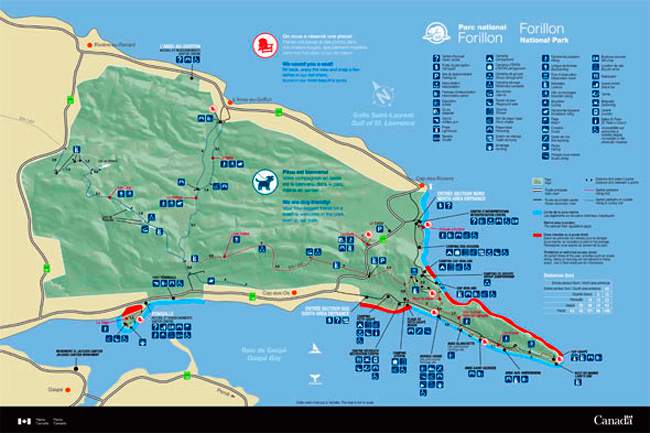
Park Map
Our goal was Cap Gaspe so we drove in as far as we could and then hiked the 4k to the point. We made the mistake of not taking the "Les Graves" trail which is more scenic but still had some good scenery including the cove where all goods and supplies for a small fishing village and the lighthouse were hauled bit by bit up the 150 foot cliffs of the cove.
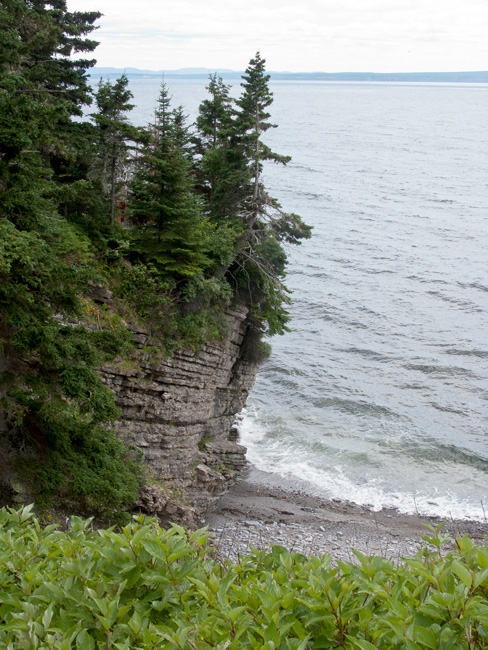

Our Only Sign of Wildlife Today (Not Sure What This Is - 9" Tall)
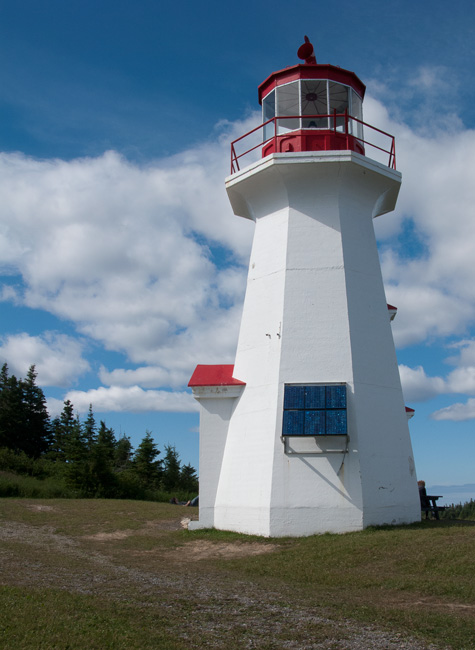
The Current 1950 Cap Gaspe Light - Not a Patch on Rosiers
As we reached the lighthouse, it was a bit of a letdown from the visit to Cap Rosier but we soon found out we were in for a bigger treat - whale watching. For the next hour or so we were lucky enough to see humpback whales surfacing, blowing, diving and breaching over quite a large area. They were just far enough away to make photographing them with a 200mm lens difficult but here are a few shots to give you an idea of the spectacle.
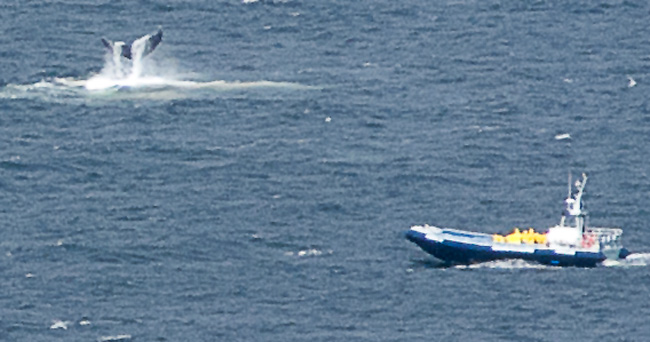
Diving with 50 Foot Whale Watching Boat Nearby
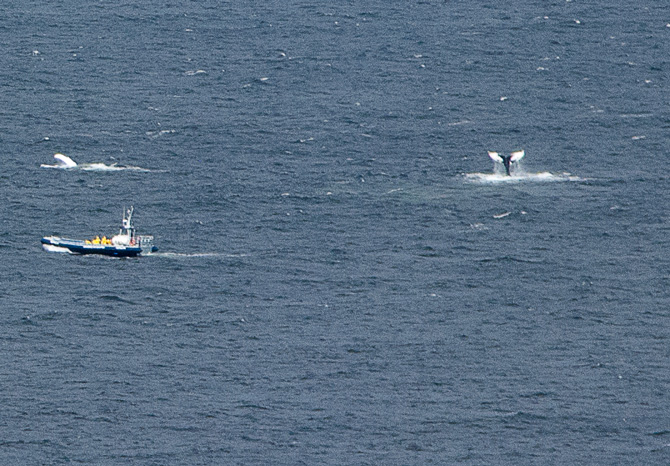
One Whale Diving and Another Rolling With its Fin showing
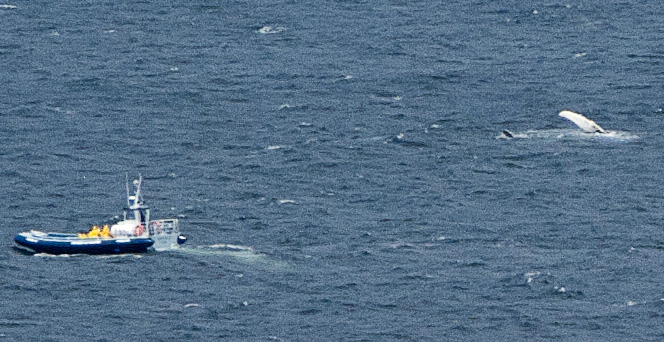
Whale Rolling
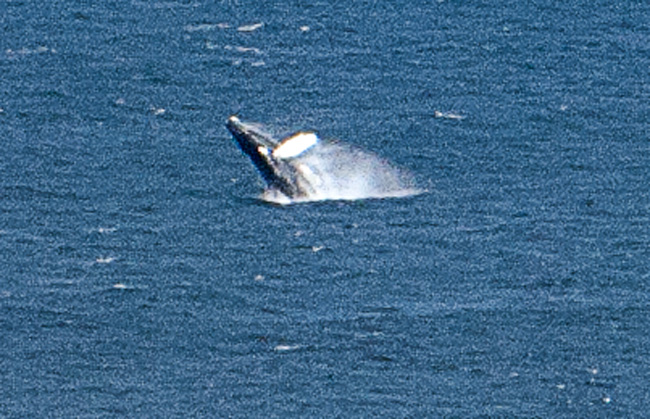
Breaching High!
We not only got to see some spectacular whale action but also had Ranger Rick (his name, really) give a commentary while it was all happening. He was also blown away by the display! The whale boat took some waves over the bow today....good job we stayed home.
Wandering around the lighthouse site we saw a signpost and on looking at it realized we were at the start of the International Appalachian Trail at Km 4455 or Km 0 depending on how you look at it. The Trail was begun in 1994 to link the end of the American Appalachian Trail in Maine to the tip of the Gaspe Peninsula. It was first walked from end to end in 1997.
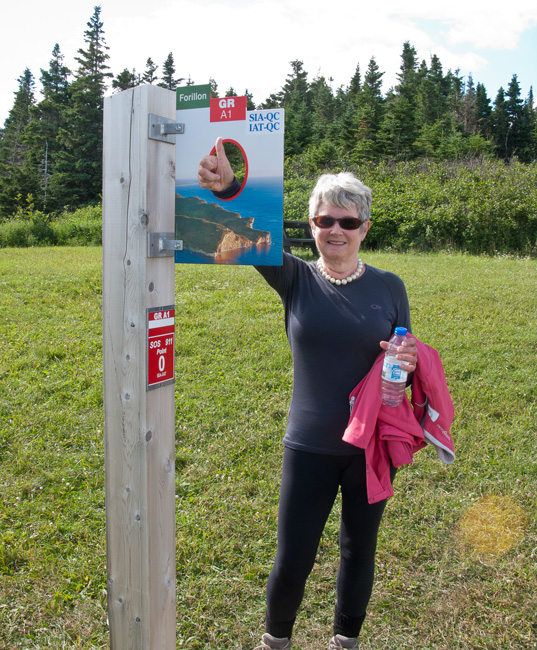
Back a few years, around 250 million to be more correct, the Appalachian Mountains were formed when the earth's plates collided to form the supercontinent Pangea. They straddled the central part of that continent in what is today eastern North America, eastern Greenland, Western Europe, and northwest Africa. When today's continents separated to form the Atlantic Ocean, remnants of the Appalachian-Caledonian Mountains ended up in the eastern United States and Canada, Greenland, Scandinavia, the British Isles, Brittany, the Iberian Peninsula, and the Anti-Atlas Mountains of Morocco.
Since the extension of the original Appalachian Trail to include a Canadian section, additional sections have been added to portions of the Appalachians in Labrador and Newfoundland. More recently, an international effort has begun to extend the Trail across the Atlantic and, as of last year, there were IAT walking trails in Maine (United States), New Brunswick, Quebec, Nova Scotia, Prince Edward Island, Newfoundland (Canada), Greenland, Iceland, Norway, Sweden, Denmark, Scotland, Northern Ireland, Ireland, Isle of Man, Wales, England, France, Spain, Portugal and Morocco. Soon someone will make history and walk the entire length of over 8,000 miles.
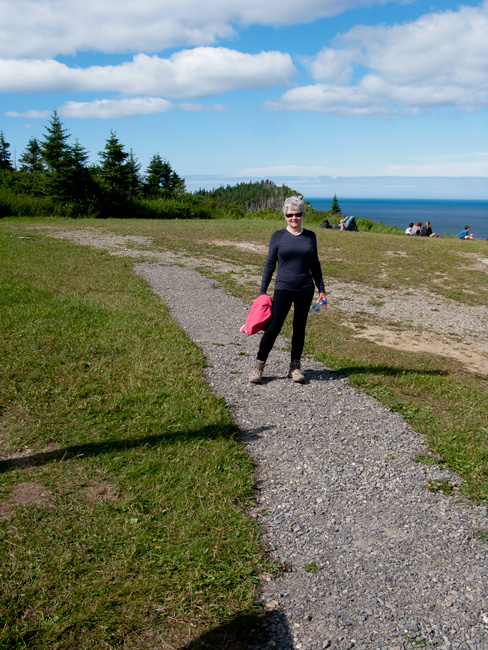
Judy Started But Thought Better of It After 10 Yards
Our wildlife luck continued after we had hiked back to the car and were leaving the Park when "eagle eyes" Judy spotted a big porcupine just off the road. Never seen one this close and it was quite impressive.

Back at the boat, we did a little walkabout of the train station by the marina. Gaspe used to be the end of the line for VIA Rail with service to Montreal and Toronto but it was suddenly stopped just a year after they built a brand new station in 2012 due to concerns about the stability of a bridge nearby. Since then, Quebec, VIA Rail, and Gaspe have been embroiled in who will pay for the improvement. In the meantime, the train sits empty with weed growing up in the rail bed.
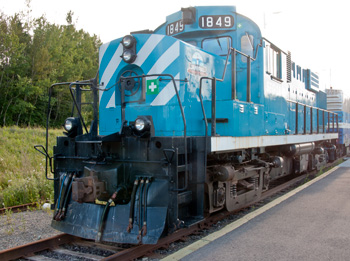

This Train Don't Go There No More! As One Local Said
Well tired after a busy day, we had one more task to accomplish.... to return the car which turned out to be a long job. Budget had a new young guy on the desk and if there was a way to mess up the check in, he found it...and created a few new ones. After an hour all was settled and he was kind enough to run me the 10 miles back to the marina. He also stopped at the LM Wind Power factory just outside Gaspe for me to get a photograph. LM is the world's biggest blade manufacturer and Gaspe is their Canadian plant, shipping all over Canada and the Midwest. LM is a significant employer in the Gaspesie area.

A 150' Blade Getting Ready to Leave
Thursday, June 21
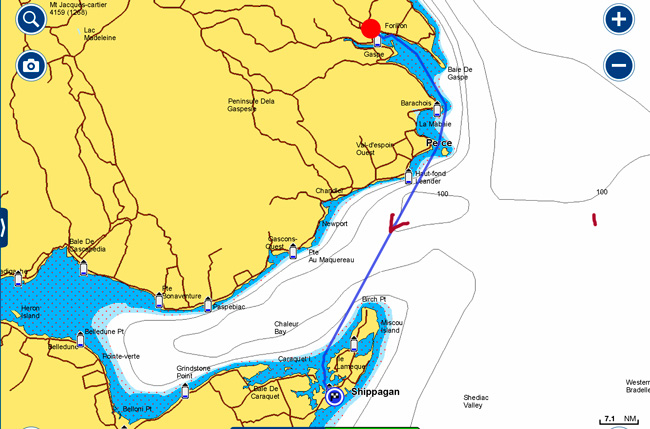
Gaspe, Quebec to Shippagan, New Brunswick - 82nm
The weather broke overnight with sun and no wind to greet us at 6:00 am for another long run. We got our own personal tour of Perce Rock and the cliffs after a couple of hours.
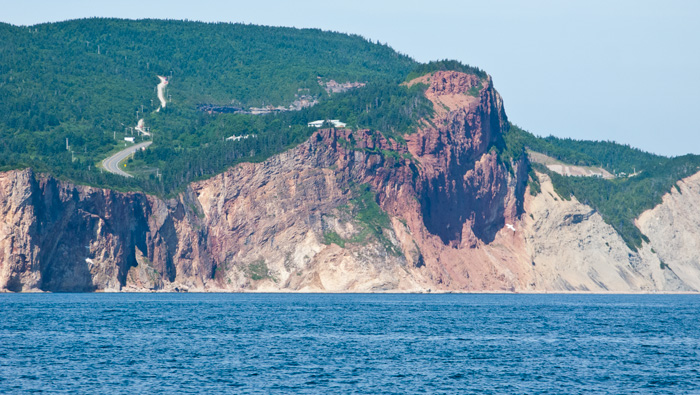
We Drove This Road Monday
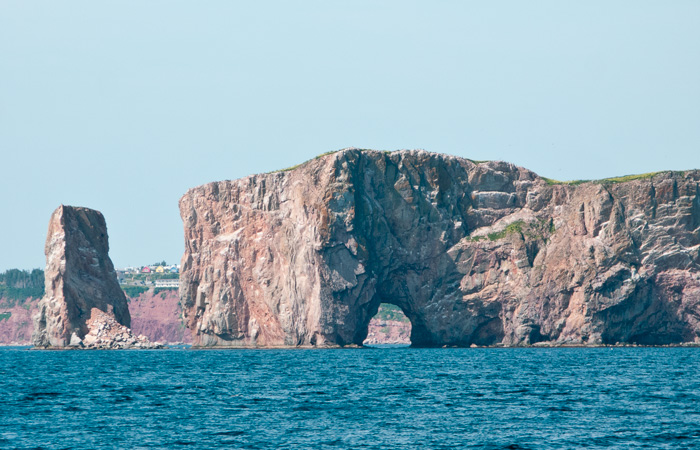
Today's run was offshore after the Cap d'Espoir Lighthouse perched high on the sandstone cliffs.....
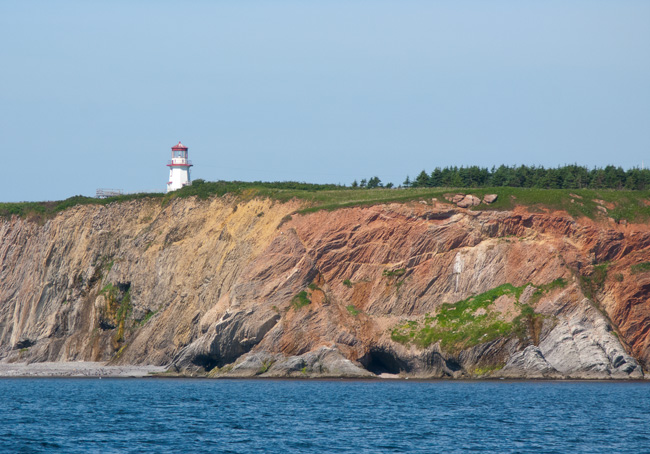
so we slowly lost sight of the defined land we have been so accustomed to until it disappeared altogether. This gave us an opportunity to try pumping out our holding tank for the first time ever as we were about 10 miles offshore. Regulations prohibit discharge into any of the Lakes and the Canadian portion of the St. Lawrence Seaway. If you are at least 3 nm offshore in the sea, discharge is permitted. We were well beyond that so we powered the pump up and it ran but the tank level did not fall; another boat job to do later. The tank was not too full but we had been warned by the gang in front that dockside pumpout facilities were few and far between.
Boat traffic was zero for the entire day until we reached the end of the Chaleur Bay when we saw a fishing boat about 3 nm off.
About 5:00pm we pulled into Les Amis de Marine (Friends of the Sea) Marina at Shippagan....goodbye Quebec, hello New Brunswick and a new time zone - Atlantic Time, with clocks going on one hour. Within a few minutes we had met Lucy, Paul, Maryse and Jacques, locals who keep their boats in the marina, welcoming us to New Brunswick...the great hospitality continues.
The boat got a good scrub down straight way today...it was if we had sprinkled the whole thing with large sea salt crystals. I guess we really had! We have been rinsing the boat down each day when we arrived in port but that only does a fair job. Hot water and a scrub seems to do a better job. I can see a major, major clean on the cards in Maine. You can already see a couple of washers that are poor quality stainless steel showing signs of rust.
That done, I made a quick walk into the small town to the marine/hardware store to look for a NB courtesy flag and was lucky enough to find one. I also found crab pots, lobster traps, wicked looking knives, nets, floats...enough to fully equip a fishing boat....and open 24/7, that's my kind of marine store. On the way back I saw a poster at the Petit Eglise (little church) for a concert tonight so checked inside and they we setting up...found the music for tonight.
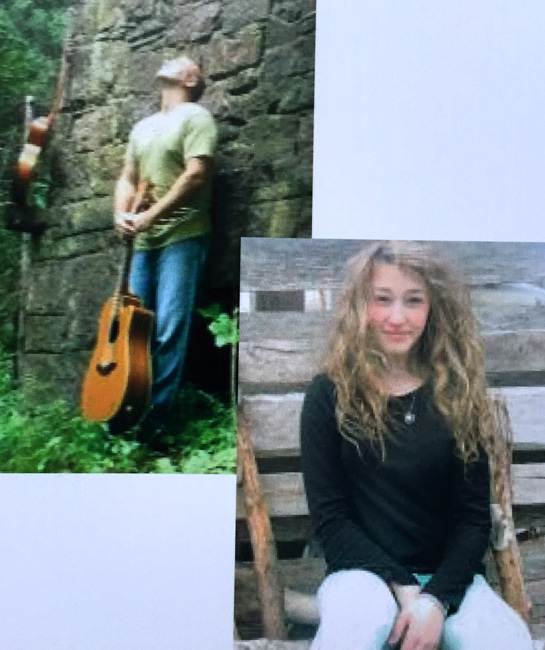
Ryan leBlanc and Alexandra Duguay
After a quick dinner we were off to the concert in one of the smallest churches we have seen so far on the trip. It a relatively small crowd and appeared to be locals.
Alexandra started the concert singing the Acadian National Anthem Ave Maris Stella a capella and then sang a variety of her own songs, accompanying herself on keyboard....what a voice!!
At the intermission, wine was served and everyone gathered outside the church to chat. Alexandra and us were the center of attention with everyone very interested in our trip. It turned out that Alexandra is only 14 .... that girl has a future.

Paul leBlanc, playing guitar, banjo, and harmonica played a long second set, all instrumentals written by him and a couple of songs with Alexandra. Paul has a unique style, playing percussion using the guitar body at the same time as playing the guitar. He can play entirely on the neck of the guitar fingering chords and somehow a spare finger to pluck strings. He did the same on the banjo. All this was accomplished playing a harmonica as well. Very enjoyable evening and we were ready for bed.
Friday, July 22
This morning, we were made honorary citizens of Acadia, when one of the marina staff stopped by with a couple of T-shirts and an Acadian flag for us to fly while we were in Acadia.
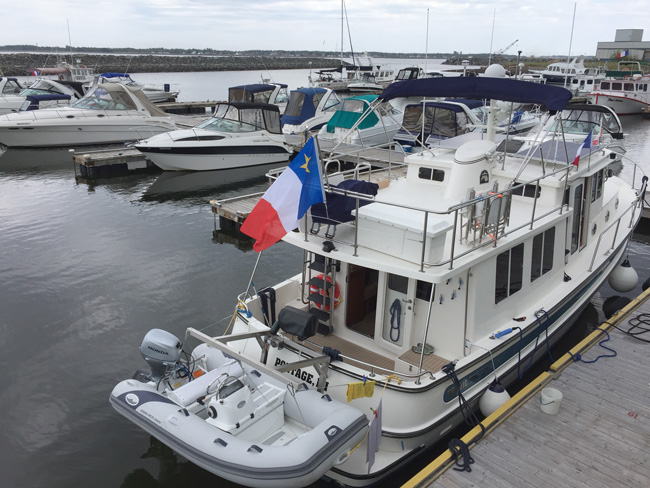
The Acadian flag was adopted in Miscouche, Prince Edward Island in 1884, during the second National Acadian Convention attended by 5000 delegates from Acadia. It was proposed by Reverend Marcel-François Richard, the President of the Commission responsible for studying the choice of a national flag and was widely accepted. Up to this point no specific flag existed to represent the French Acadians. The red, white, and blue of the French tricolor was chosen to represent the strong links to France and the Stella Maris that is the star of the Virgin Mary was added in the blue field of the flag. The yellow of the star represents the color used by the Catholic Church.
The New Brunswick flag is shown below but, in our observations, is not seen as much as the Acadian flag since the NB population have very strong Acadian roots.
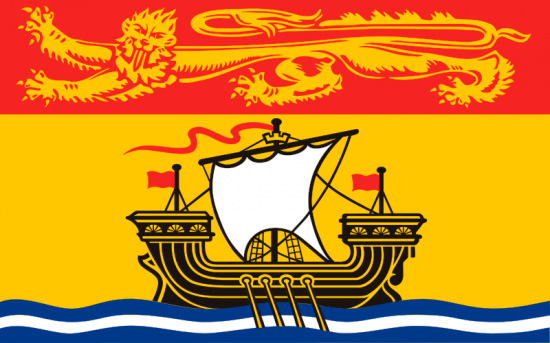
The holding tank pump was a priority this morning and I was not looking forward to this sh...y job. other than working in very cramped quarters and cricking my neck for a week, it all came apart easily and the problem solved - cherry stones holding the valves open. How did they get there - well let's just say we often swallow cherry stones. My mother warned us as kids that cherry trees would grow in our stomachs if we swallowed cherry stones....she didn't say they would clog the holding tank pump! While all was apart, I thought it would be good to replace the duckbill rubber valves as they were a bit hard so off to the marine store. They had never heard of Whale Pumps. Met Paul from yesterday as I was walking the 2km to the other marine store and he gave me the keys to his car. Same story at the other large marine store. Moral - carry spares for all of your Whale pumps. Everything went back together with no left over bits, always a good result... the real test will be tomorrow.
With the morning gone, we set out to take a hike along the shore on the 3km boardwalk, an impressive structure, past the old retired Shippagan lighthouse. About every 400 yards, they had Interpretive Boards outlining the history of Shippagan, its geology and its ecology; by the end of the walk, we had a good knowledge of Shippagan.
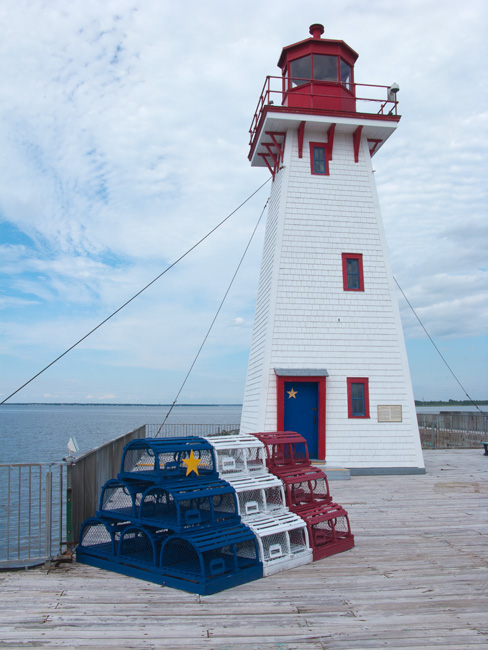
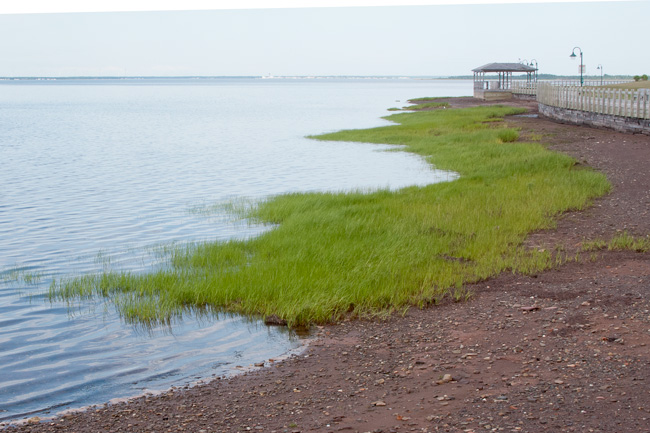
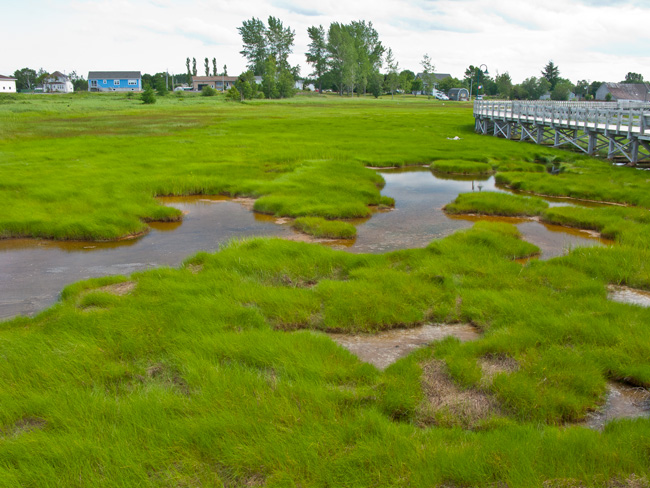
Salt Marshes at the Far End of the Boardwalk
While Judy vegged out on the boat, I walked over to the commercial port to take some photos of fishing boats but was it was totally deserted except for one boat - not even a car parked in the huge lot. Wondering why, I spotted the Canada Ocean and Fisheries office and went in. All quiet there so I wandered down a hallway and the staff were all taking a break in their lounge with the TV on.
I joined them for coffee and they explained that the real commercial fishing was done for the year with just some shrimping going on a couple of hundred miles offshore. About the only fishing now is for mackerel that is used as bait for crabbing and lobstering. They are frozen and stored in cold storage until next season. They had only one boat in the port this week. All the boats have been hauled to dry land, crab pots stacked, nets repaired, and thousand of feet of floats piled 8' high. Until early next April, things are dead and then a frantic burst of activity takes place to launch over 100 large boats and load them ready for the season. From then on, fishing is a 24/7 occupation until late June when they pack up. In those three months, they pack a year's work in for "normal" people.
Somehow I "lost" my photos of the boats on the hard...these were serious deep sea fishing boats with bows 20' high and big bulb bows like the freighters. If I find them on the computer, I'll add a couple wherever we are.
Saturday, July 23
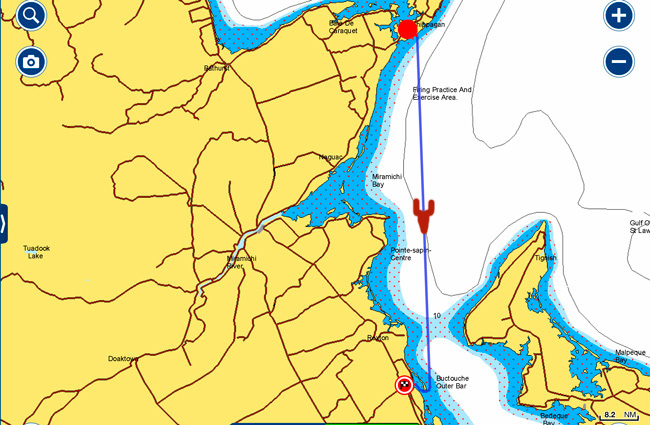
Shippagan to Bouctouche - 92nm
Left at daybreak (5:30 am) for a long run hopefully to Bouctouche. The weather looked good with respect to wind and waves but the skies were flat grey and so we were hopeful that we could make the run and meet up with the rest of the gang. Our plans were thwarted when we arrived at the lift bridge a couple of miles away to find out that they had mechanical problems and could not raise the bridge; they were waiting for a repair crew to arrive - should be done in a few hours. Back to the marina, tie up again and wait. Around 8:00 am, we got the word that the bridge was operational again so off we went.
Stephen on Tug'n had warned us about the current in the Shippagan Gut (channel) and we were well off the best time to go through. When we arrived, we found the channel was narrow with an old derelict seawall to starboard that had large gaps for a couple of hundred yards. The current was just ripping sideways through these breaks and we went through the channel at 11 kts barely under control. They are replacing the breakwall with one of concrete that will stop the cross current but add to the flow straight down the channel - it will be exciting. The 'bible" warned about going against a South or Southeast wind and it was clear that you could get huge waves at the mouth.
The trip was very uneventful until the end, except that the holding tank pump did its job. There weren't even any boats to photograph just a lighthouse near Shippagan that needed a good coat of paint.
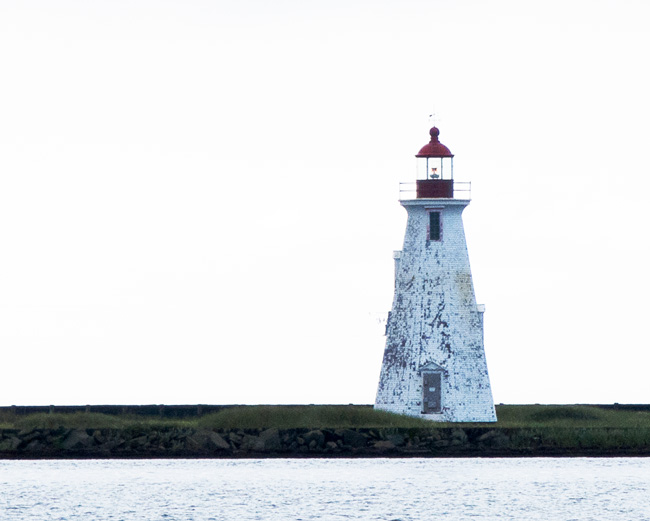
The only thing of note was the last few miles when there was a big storm hanging over Bouctouche with black clouds,lightening and thunder. The channel into Bouctouche is very shallow but well buoyed and about six miles long. We ended up circling in open water clear of the storm rather than run into it in a narrow channel with buoys not shown on our chart plotter.
The storm passed and we made the hour long trip into Bouctouche where the gang was ready to take our lines for us. Here at last and only 14 hours after we originally left!!!
We crashed after half an hour of catching up and a quick shower.
Sunday, July 24
Woke to a beautiful day, got our bikes down and headed for breakfast with the gang. No Quebecoise but we're in New Brunswick now. After breakfast, we all split up to do our own thing and we decided to bike around the shoreline to Le Pays De La Sagouine, a theme-type village that we had read about in a French language brochure that seemed to depict the history of the area through music, comedy, demonstrations, etc. Based on this we would either have a great time or it would be a bust!
Paying our money, we saw the first view of the village located on a small island, Ile aux Puces linked to the mainland by a causeway. (They provide the frame you take the photo). It was very quiet for a Sunday in the middle of the tourist season which made us a bit apprehensive.
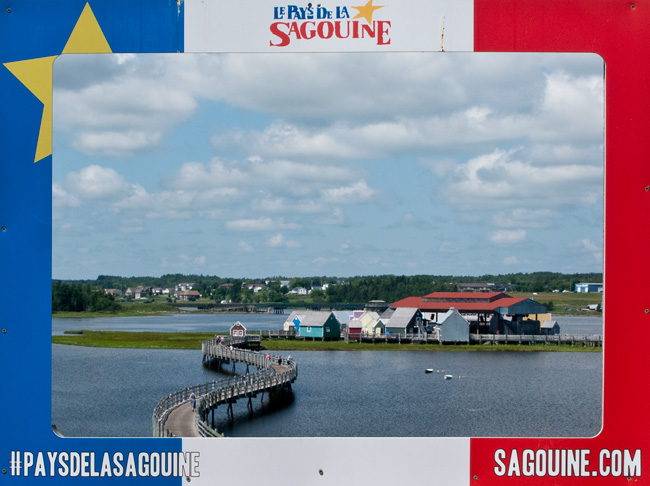
Arriving at the brightly painted little houses....
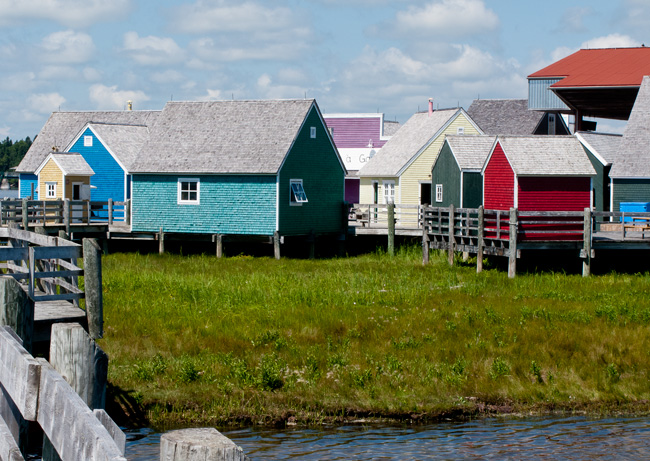
things looked a little better with a large covered open air theater/stage where a band was performing a variety of Acadian songs and music. Very accomplished musicians, all with good voices.
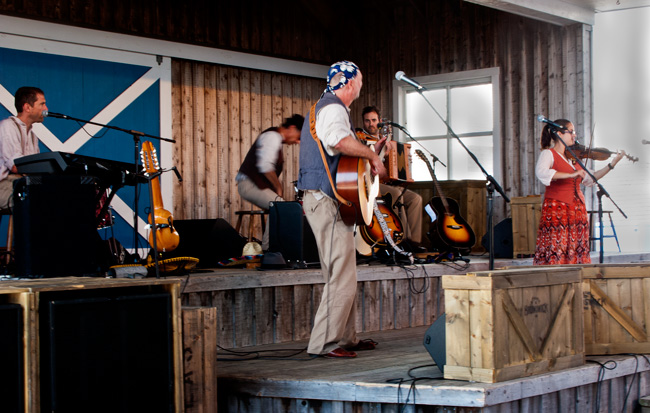
Every so often, new people emerge from the nearby cafe or other building around the theater and perform a couple of songs (in Acadian French).......
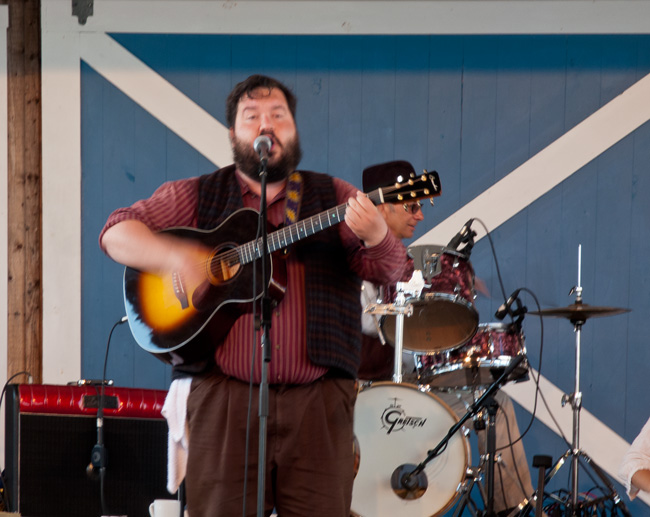
We were a bit baffled when this old lady in the center shuffled out of one building on to the stage with a loud cheer from the audience and sang the final song of the hour-long set. Not to great a voice but the crowd were very appreciative.
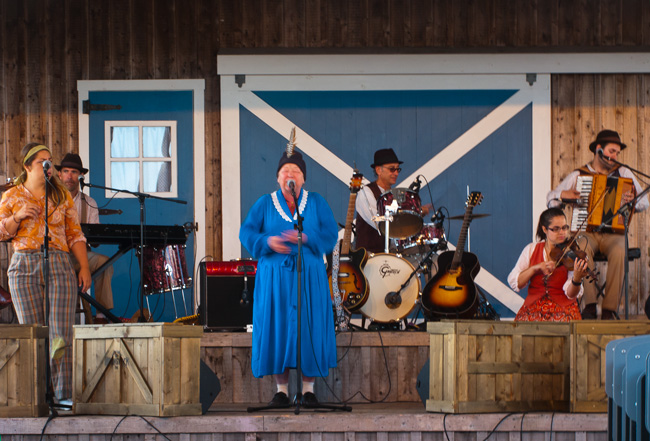
With what appeared to be a break in the music action, the old woman appeared on the balcony of a nearby building, dressed as the priest and performed a comedy skit with another character below. Although in French, we managed to get the general idea and some of the punch lines. At the break, we wandered around the village towards the small lighthouse where several buildings were set up with period interiors or themes.
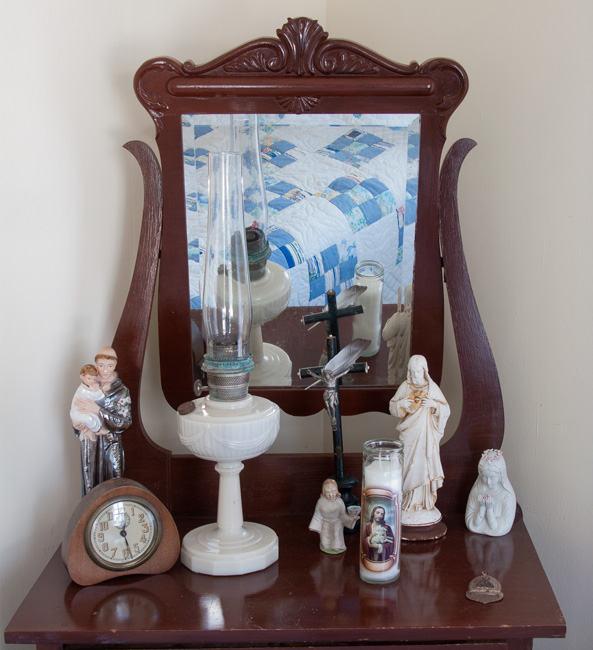
Just One Corner of a Whole House With Very Devout Residents

No PC Here!
One was a barber's shop, originally in Bouctouche, that had had two generations of hairdressers serving Bouctouche for almost 90 years.
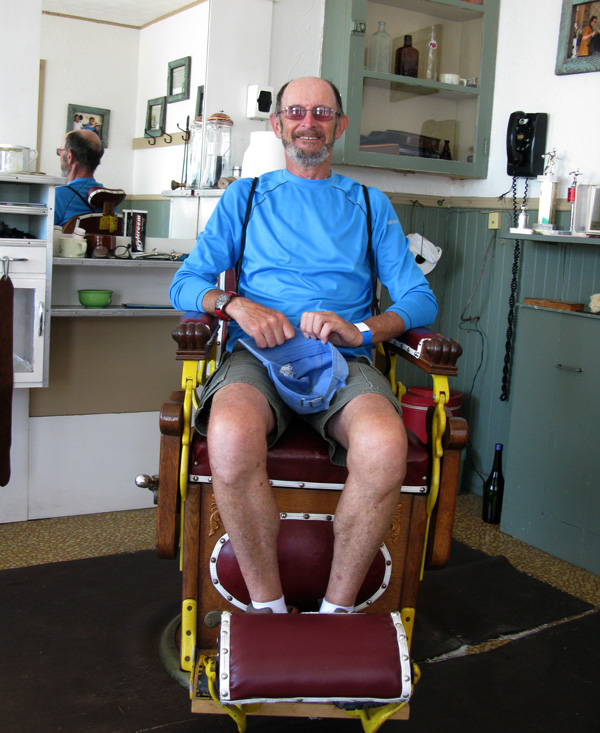
Unfortunately, It was the Barber's Day Off
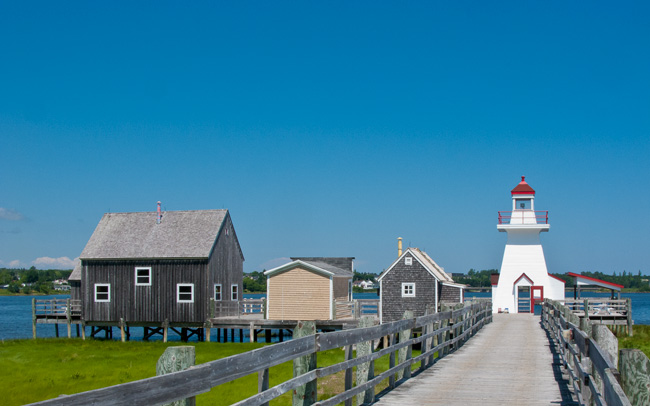
It all became a little clearer, when we went to the next building, a museum to ......
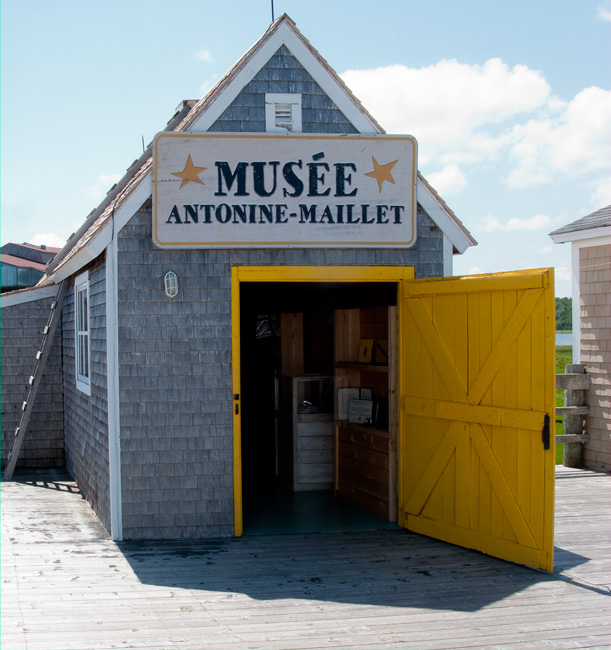
The Museum housed many artifacts of Antonine and it was clear that she was an Acadian author of wide renown who wrote extensively about Acadian culture. She is particularly famous for her creation of La Sagouine (the Cleaning Lady) a melding of the lives of three real-life Acadian women who lived in Bouctouche. A collection of monologues, published in 1971 and performed on stage as a one woman show. La Sagouine inspired many theatre productions and television shows.
A symbolic character of Acadian culture, La Sagouine is well known throughout Canada and Francophone Europe. Thus began work on the book that through its monologues tells of the simple life of La Sagouine, the daughter and wife of fishermen who became a charwoman. La Sagouine gained fame in the theatre and on the CBC French network. Through the years, Viola Léger was the only actor to interpret the role (in both English and French) of this character. Madame Léger portrayed La Sagouine in Canada, the United States and Europe. She played the role more than 2,000 times over 40 years. La Sagouine, the colorful Acadian woman whose real name we never know, speaks without fear in Chiac, her local language, about religion, of life's difficulties, of the rich and the poor, of justice, and becomes the voice of the people.
La Sagouine was such a hit that in 1992 a tourist park, Le Pays de la Sagouine, was opened in Bouctouche, N.B. where visitors could immerse themselves in the Acadian spirit and learn about the world of Antonine Maillet's most celebrated character. Viola Leger still performs her monologues at Les Pays every week.

With this background gained, we were definitely more informed about the whole idea of Les Pays and how it all fit together. Even more so, when we sat in on a talk about Acadian history, culture, and where I picked up some of the complex history and deprivation the Acadian people went through; not one of England's proudest moments, but then then we haven't always been the best colonists like many other countries. We learnt about the two foot Acadian percussion and how to play the spoons. It was interesting to note that Acadian musicians also use the bodran drum, normally more associated with Gaelic and Celtic music. There are strong common roots to all three types of music.
For anyone interested in learning more about Acadia - click on this link
Henry Wadsworth wrote one of his epic poems, Evangeline, about the struggles of the Acadians - click on the link below
The day continued with more enjoyable music and comedy. We missed the demonstrations as they are scheduled early in the day.
The gang joined us in the Les Pays restaurant at the end of the day for music and a seafood dinner.

May 16 - 22 |
May 23 - 29 |
May 30 - Jun 5 |
Jun 6 - 12 |
Jun 13 - 19 |
Jun 20 - 26 |
Jun 27 - Jul 3 |
Jul 4 - 10 |
Jul 11 -17 |
Jul 18 - 24 |
Jul 25 - 31 |
Aug 1 - 7 |
Aug 8 - 14 |
Aug 15 -21 |
Aug 22 - 28 |
Aug 29 - Sep 4 |
Sep 5 - 11 |
Sep 12 - 18 |
Sep 19 - 25 |
